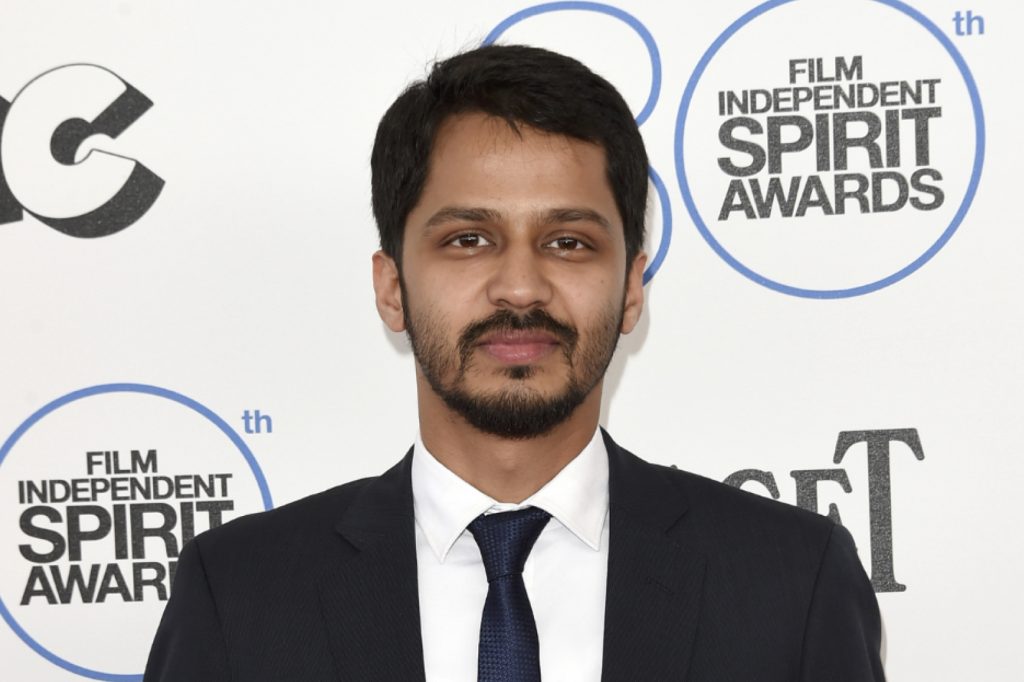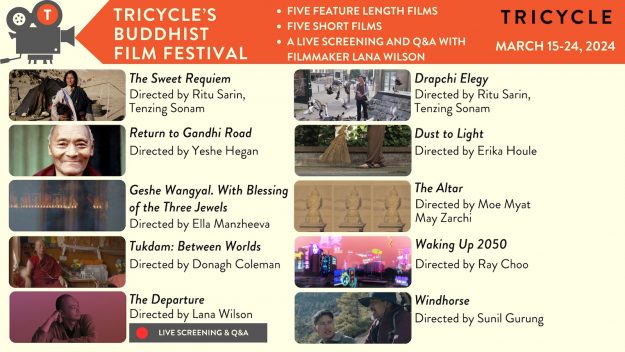From March 15–24, Tricycle will conduct our inaugural Buddhist Film Festival. Over the course of ten days, audiences will hear a variety of stories from a diverse set of perspectives, including a story about a former punk-turned-Buddhist-priest who makes a career helping suicidal people find reasons to live and the story of Namdol Lhamo, an anonymous exile living in Brussels who also happens to be one of the famous Singing Nuns of Drapchi.
This unique selection of films—spanning documentary, fiction, arthouse, and shorts—is thanks to the festival’s inspired curator: award-winning filmmaker, producer, and NYU professor, Shrihari Sathe. Sathe took home the Independent Spirit Producers Award in 2019 as well as the Cinereach Producer Award in 2016.
Tricycle recently caught up with Sathe to talk about the importance of diverse perspectives, staying scrappy on set, and the universal challenge of trying to portray the unportrayable.
What makes a good Buddhist movie? It’s pretty broad. Buddhism is such a vast religion, with a lot of ideologies and teachings. Many of these films speak to Buddhist values and different Buddhist traditions, but there’s no one kind of Buddhist.
Most of the films you are showing are documentaries, which range from works exploring Tibetan funeral rites and tales of cultural diaspora to shorts about the Zen art of cleaning and surreal odes to altars. What, if any, connective threads do you find between all of these works? Across all the fiction and the nonfiction, one of the common threads that I see is that a lot of these films explore identity in their own way, as well as different kinds of universal truths, something that kind of connects us beyond just the physicality of being in a place with a more philosophical connection. For instance, in The Sweet Requiem, Dolkar is a character who is trying to find her place in the world and is trying to find her identity as it relates to being a Tibetan refugee in India. In The Departure, Nemoto—who is the principal subject—is running a suicide helpline, and he is, again, working with people who come to his community and helping them to find themselves, but he is also providing teachings about Buddhism and Buddhist life to the participants in his program. In Windhorse, we have a short about a father and son trying to come to terms with their relationship. So these are the sort of common threads that I think flow through the films. With Waking Up 2050, we are taking a surrealist “past versus the future” look at what it means to be a practitioner now versus what that is going to mean in the future.
Waking Up 2050 definitely caught my eye for its emphasis on how some aspects of Buddhist tradition are changing and evolving. Was there an intentional push and pull here between the stories more rooted in more ancient wisdom and those which present a more modern take on practice? Yeah, I think that one of the reasons I wanted to include the film was because a lot of the films and documentaries are looking at the past, right? They’re looking at how a monk maybe escaped Tibet when the occupation was happening, or looking at a person’s teachings, like in how Geshe Wangyal influenced Western thinkers, or like The Sweet Requiem, which is looking at this character’s journey from the past, or with Tukdam: Between Worlds, we’re looking at Buddhist practitioners of tukdam, which is the kind of state of being even when you are potentially dead, or pronounced medically dead. So with Waking Up 2050, I wanted to show that there’s also a forward moving path that Buddhism is having and looking at how inclusive the religion is shaping up to be in some ways. In these selections, you will see we have the first Western woman to be ordained in Bhutan, we have a LGBTQIA+ activist who was a makeup artist but was in school to be a monk. So I wanted to showcase that there are some modern elements that are being incorporated in some ways into the religion. And the approaches of the different filmmakers are quite interesting as well, where some are using graphic neons and using projection mapping in their works, while others have films that are more based in talking head interviews.
You mentioned Tukdam: Between Worlds. It’s such an interesting film, for a lot of reasons. One of the reasons that I’m interested in it is because of what it attempts to do, because many concepts in Buddhism are hard to explain, and even harder to show or visualize. A few of the films deal with these hard-to-portray concepts. In your experience, what makes these films successful? That’s a great question, because that’s not just in Buddhist film, for instance, it’s in any kind of film. A filmmaker, in a lot of ways, succeeds if they can visually or sonically portray an internal struggle of some way. And I think a lot of these films kind of do that very successfully with relationships between characters or relationships between a physical being and a space. Just even looking at Tukdam, the subjects in those instances are advanced meditators, so we’re seeing them in their surroundings, but we’re also seeing them basically die in a consciously controlled manner, or having a way to keep their bodies fresh, even though they are medically pronounced dead. And I feel like the filmmaker captures that really well by showcasing the physical bodies within the physical space as well as the way the supporting subjects—the other subjects that were around the meditator who is in a conscious state but not in a physically alive state—interact with the body as well. So I feel like there are ways filmmakers are able to juxtapose internal conflicts or internal modalities through physical space, and a lot of these films do that successfully.
Some of these documentaries are made with people who have closer ties to their subjects—whether through the religions or ethnic background of the people being documented—while others are coming from people who are very interested in these practices but might not have as much of a direct personal connection. Do you see differences in how these documentaries eventually land, or how they’re driven, or what their mission is? I mean, I feel like every filmmaker is trying to portray a topic of interest to them, and films, by default, have no one trajectory because they’re inherently unique, especially like documentaries—they’re quite unique in the way the filmmakers approach their structure, their style, their narrative. That’s why I wanted to include not just documentaries about Buddhism directly, but I wanted to include diverse perspectives that identify or tell stories about many of the different aspects of Buddhist culture and religion.
In 2019, you won an Independent Spirit Award, and I feel like that Independent Spirit value runs through a lot of the films that you’ve chosen. A lot of them were done either on a smaller budget or are more DIY or scrappy in the way that they’ve been put together. Often that is because, for more cutting-edge ideas, you need to take the initiative to actually get the film made. Do you see this Independent Spirit in the techniques of the filmmakers that you’ve chosen? Yeah, I mean, absolutely. I think that one of the things is that some stories just inherently are more independent-friendly because maybe traditional film financiers or studios don’t see a commercial avenue for them, but that doesn’t mean that these films should not get made and should not be seen. So filmmakers—both directors and producers—will find avenues to put the projects together despite it taking a while. I’m sure a lot of these films, especially the feature-length films, took many years to put together. One of the things that drives most independent filmmakers is a desire to create and a desire to tell the stories that they want to tell, to make them, and, eventually, once the film gets made, that an audience might start to embrace them. Now, it’s getting more and more challenging for films to break out because there’s just so much content. There aren’t as many arthouse theaters, so film festivals are a way for filmmakers to reach an audience, and also a way for an audience to seek stories about their own personal circumstances or personal experiences that they might not traditionally find in other places. A lot of these films, even though they are Buddhist-themed, speak to universal truths, where there are definitely things that an audience member—who maybe is not Buddhist or not familiar with Buddhist culture or religion—can still identify with.
Thank you for subscribing to Tricycle! As a nonprofit, we depend on readers like you to keep Buddhist teachings and practices widely available.

